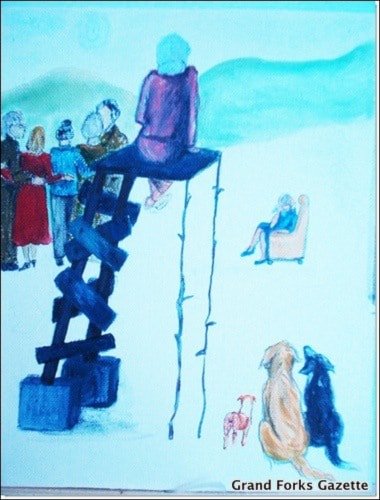In previous columns, we looked at denial and distraction as ways to avoid our creativity. The third coping mechanism that muddles contact with an urge to create is dissociation.
“Dissociated experiences are not integrated into the usual sense of self, resulting in discontinuities in conscious awareness” says Stephen Joseph, British professor of psychology, author of What Doesn’t Kill Us. I know of a woman who signed up for a drawing class.
When asked how she was enjoying the group, she had no recollection of having attended the first session, of having stopped going to the group, or why, “An amnesia that is so extensive that it is not due to ordinary forgetfulness.”
“Disengagement and compartmentalization to a greater or lesser degree can be part of the altered state of consciousness and are more than denial.”
The supplies for painting can be on view, in one’s space, for months and never approached. One reader spoke of beginning a painting but never finishing it because a connection to the painting no longer existed in her mind. These could be said to be examples of what is “often left behind in childhood: the freedom of expression and creativity.”
Such experiences are symptoms of post-traumatic stress disorder (PTSD). Psychology has come to understand that PTSD can be triggered by life stresses that fall far short of military traumas and is bringing PTSD into the more manageable realm of coping mechanisms.
Perhaps we could call it Previous Turmoil equals Sad Disarray to expand an understanding of its effects.
CBC’s The Current on Jan. 18, described PTSD as a public health issue. Such stressors as prolonged early life trauma, confrontation with death, chronic drug use in the home, can cause the chemical changes in the brain associated with PTSD and produce some or all of the following symptoms to varying degrees: difficulty in relating to anyone else, shrinking in order to feel safe, numbness, cannot focus, anxious, feeling of impending doom, panic attacks, flashbacks, depression and eating disorders.
Stanley Joseph explains that the brain automatically tries to “assimilate” current experiences in the filing cabinet of the past, with less than satisfying results.
What we can do is recognize that there is no going back, what has happened to us is who we are now, and create a new filing cabinet and “accommodate” our current experiences there.
Some people assume that difficulties in expressing creativity prove they don’t have “a creative bone in their bodies.” In understanding that such difficulties are coping mechanisms for dealing with trauma from the past, it is possible to experience a wonderful sensation of peace, of relief, and a renewed strength to change surviving to thriving.
It’s an acknowledgement that something unhappy and shocking happened, perhaps for the first time if memory does not permit acknowledgment.
Dissociating from past memories, in order to feel safe, means the loss of the pictures in one’s mind, of imagination, of the capacity to visualize, leaving only grey facts, and limiting creativity to copying.
Focusing on a recent happy event might give a glimpse of what memory can be: colourful, three dimensional, fluid, detailed, and extremely pleasurable – like the pictures in your mind – and help understand why one might refuse such vividness in past memories.
And lastly, let’s speak of the symptom of “shrinking to feel safe.”
Creativity is energy, and must be dissociated from, if the only way to feel safe is to be alone, to shrink from one’s energy, one’s pictures, one’s memories.
Denial, distraction and dissociation lead to an illusion of safety. The desire to create is the lifeline that keeps tugging us back to who we really are.
– If you would like to talk about your art or comment on what you see here or would like to see here, we can be reached at artpalette@hotmail.ca.
